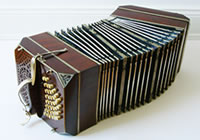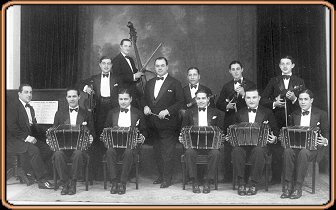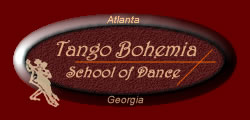Argentine Tango Music

Bandoneon - the sound of Tango
Music is the essence of Tango. It is hard to describe, yet easy to recognize. It draws your attention, makes you want to move.
Dancers divide Tango music in two major types: danceable and non-danceable. It does not mean one type is better than another, it’s just non-danceable music is best for listening and not for dancing. When at a dance party, called a milonga, we want danceable music only. It could be old (traditional), or new (nuevo), but it’s got to have a clear beat and a melody that dancers can use to create the movement…
Here I will present several pages out the book on Tango music and dj-ing written by Arnoud de Graaff, a Tango DJ out of Nijmegen, The Netherlands (with his permission). I met Arnoud in 2006 when traveling to El Corte to participate in Teacher Training Week by Eric Jorissen. He has a tremendous knowledge of Tango history and music.
==================================================
3 Classification of (Tango) Music
3.1 Introduction
There is so much tango music and music to dance tango to, that it is easy to loose yourself in it … we use the following classification criteria:
- Instrumental & vocal
- Rhythmical & lyrical
- Slow & fast
- Energetic & melancholy
- Regular/simple & irregular/complex
- Old & modern

Orquestra Francisco Canaro
3.2 Instrumental & Vocal
Some tangos are music without singing. Other tangos contain also singing, where music accompanies the singing. Tangos without singing are instrumental, tangos with singing are vocal tangos or tango cantandos.
Some dancers flatly refuse to dance to tango cantandos. Of course this depends on the way a singer sings.
Singing which is integrated into the music will meet less opposition than too demonstrative singing, which only uses music as a background. Too demonstrative singing can be fun for a special occasion, but it soon might irritate the dancers. Whatever you do as a DJ, it is always wise to alternate (series of) instrumental tangos with (series of) sung tangos.
3.3 Rhythmical & Lyrical
Nearly all music is rhythmical and tango music certainly is no exception to this rule. To paraphrase George Orwell’s Animal Farm: all musical expressions are rhythmical, but some are more rhythmical than others.
So some music however is clearly more rhythmical than other music or at least the rhythm is more obvious. Rhythmical music is music in which the musicians clearly accentuate the music.
For dancers it is clear when to make the next step. Especially beginning dancers are fond of rhythmical music. D’Arienzo is super rhythmical, just listen to his versions of Eduardo Arolas’s Derecho Viejo or Enrique Delfino’s Re Fa Si and you know what rhythmical means.
Lyrical music is music with a less clearly accentuated pattern. The musical theme in lyrical music is more relaxed, more freely interpreted. Lyrical music is harder to dance to and poses more challenges to be creative. One of the best examples of lyrical music is Carlos Di Sarli after 1942. His version of Verdemar is a good example of lyrical music. The rhythm is hidden behind lyrical music lines and romantic lyrics by Roberto Rufino.
On deciding whether music is rhythmical or lyrical, just ask yourself if the melody or the rhythm is dominant. If the melody is dominant, a song is lyrical.
3.5 Slow & Fast
The beats per minute (BPM) or tempo determines whether a piece of music is slow or fast. Pieces of music with less than a certain BPM can be considered slow, etc. Any division of what is fast, medium or slow is arbitrary. You might use the following limits, but it is only a suggestion.
| Type/rhythm | Slow | Medium | Fast |
| Tango | < 60 | 60 – 70 | > 70 |
| Milonga | < 85 | 85- 110 | > 110 |
| Valse | < 70 | 70 – 80 | > 80 |
| Specials | < 60 | 60 – 70 | > 70 |
…
3.4 Energetic & Melancholic
Energetic music is music with a drive in it, it ‘pushes’ you in a direction. Melancholy music lacks this drive almost completely, so that it ‘pulls’ you in a direction. In the beginning of a salon, at least the first two or three hours, the accent should lie on energetic music. After that melancholy music can be played more often. Too much melancholy music will depress the dancers. In my opinion at least 70 to 80 percent of the music in a milonga should be energetic.
Energetic music is music which gives you ‘dancing energy’, that is something you can find in Osvaldo Pugliese’s oeuvre: La Yumba is raw energy. The king of melancholy is probable Carlos Gardel. Listen to Volver and weep, then you will know what melancholy means.
On deciding whether music is energetic or melancholy, just ask yourself : does it give me energy or does it consume energy?
3.6 Regular/Simple & Irregular/Complex
Regular music is music with a fixed rhythm and a simple theme, which repeats itself. By far the most of tango music you hear in a salon is simple, regular music. Most dancers (but especially beginners) appreciate this simplicity, for most of the dancers don’t dance to the music but to the beat. They love it for its predictability.
There are also orchestras, who love to play with the rhythms and use several themes in their music. The result is that their music is irregular and complex, for most dancers it will soon be too complex. Experienced dancers love to play while dancing to this music, but remember that a tanda of 3 complex tangos is already quite tricky. The emphasis in a milonga should be placed on simple, regular music.
The king of rhythm is Juan D’Arienzo. His El Choclo versions (Angel Villoldo) is the most regular music I know. One of the best examples of irregular or complex music is Julio De Caro. Listen to Floras Negras and you will realize how complex and irregular this music is. His music was so complex and irregular that it was and still is considered hardly ‘danceable’ at all.
3.7 Old & Modern
Since the early fifties tango has lost much of its popularity to the emerging rock and roll, rhythm and blues and pop, which heralded the era of the youth culture.
A lot of tango orchestras folded, were lost in anonymity or continued their activities with a more condensed line up. In the fifties tango went underground, only to make a (modest) comeback in the eighties. To draw the line between old and modern tango music is risky, but it is certain that the mid fifties to early sixties meant a distinctive trend break in tango music.
However before and during the fifties and sixties there also were musicians who innovated tango (Gobbi, De Caro & Piazzolla) and in the sixties the retro tango orchestra of Miguel Villasboas produced music, which reminded of the thirties.”
==================================================
If you are interested in more information about music of Argentine Tango, there is a lot of historical reviews found in the Internet.
But Argentine Tango is not only about milongas, music,or shoes, it is also about Tango Art – paintings. On this website we feature two artists that decided to dedicate some of their work to Tango. Check out Misha Lenn’s work using the link above!
